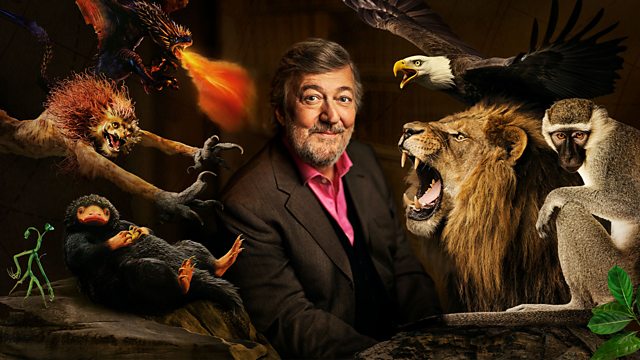Fantastic Beasts – A Natural History: Stephen Fry embarks on a fascinating journey to discover the stories behind some of the world’s most fantastic beasts. Mythical creatures have fascinated us for thousands of years, but why are we still captivated by these mythological beasts, even in this modern age of science and technology? With the help of scientists, historians, writers and film-makers, Stephen finds out why the world of magical animals is more popular today than ever before.
Alternative stream
By digging for dragons, meeting distant relatives of the unicorn or swimming with an unlikely inspiration for mermaids, Stephen uncovers the secrets behind some of our best-loved mythical creatures, and reveals the real-life beasts that have inspired some of the greatest legends in history, from rhinos to narwhals, vervet monkeys to manatees. These are the stories of the world’s most fantastic beasts.
Fantastic Beasts – A Natural History
Stephen Fry
Stephen John Fry (born 24 August 1957) is an English actor, broadcaster, comedian, director and writer. He first came to prominence in the 1980s as one half of the comic double act Fry and Laurie, alongside Hugh Laurie, with the two starring in A Bit of Fry & Laurie (1989–1995) and Jeeves and Wooster (1990–1993). He also starred in the sketch series Alfresco (1983–1984) alongside Laurie, Emma Thompson, and Robbie Coltrane, and in Blackadder (1986–1989) alongside Rowan Atkinson. Since 2011, he has served as president of the mental health charity Mind.
Fry’s film acting roles include playing his idol Oscar Wilde in the film Wilde (1997), for which he was nominated for the Golden Globe Award for Best Actor; Inspector Thompson in Robert Altman’s murder mystery Gosford Park (2001); and Mr. Johnson in Whit Stillman’s Love & Friendship (2016). He has also made appearances in the films Chariots of Fire (1981), A Fish Called Wanda (1988), The Life and Death of Peter Sellers (2004), V for Vendetta (2005), Sherlock Holmes: A Game of Shadows (2011) and The Hobbit film series. Between 2001 and 2017 he hosted the British Academy Film Awards (BAFTAs) 12 times.
His television roles include Lord Melchett in the BBC television comedy series Blackadder and the title character in the television series Kingdom and Absolute Power, as well as recurring guest roles as Dr. Gordon Wyatt on the American crime series Bones and Arthur Garrison MP on the Channel 4 period drama It’s a Sin. He has also written and presented several documentary series, including the Emmy Award-winning Stephen Fry: The Secret Life of the Manic Depressive, which saw him explore his bipolar disorder, and the travel series Stephen Fry in America. He was the longtime host of the BBC television quiz show QI, with his tenure lasting from 2003 to 2016, during which he was nominated for six British Academy Television Awards. He appears frequently on other panel games, such as Just a Minute and I’m Sorry I Haven’t a Clue.
Legendary creature
A legendary creature (mythical or mythological creature) is a type of fictional entity, typically a hybrid, that has not been proven and that is described in folklore (including myths and legends), but may be featured in historical accounts before modernity.
In the classical era, monstrous creatures such as the Cyclops and the Minotaur appear in heroic tales for the protagonist to destroy. Other creatures, such as the unicorn, were claimed in accounts of natural history by various scholars of antiquity. Some legendary creatures have their origin in traditional mythology and were believed to be real creatures, for example dragons, griffins, and unicorns. Others were based on real encounters, originating in garbled accounts of travellers’ tales, such as the Vegetable Lamb of Tartary, which supposedly grew tethered to the earth.
A variety of mythical animals appear in the art and stories of the Classical era. For example, in the Odyssey, monstrous creatures include the Cyclops, Scylla and Charybdis for the hero Odysseus to confront. In other tales there appear the Medusa to be defeated by Perseus, the (human/bull) Minotaur to be destroyed by Theseus, and the Hydra to be killed by Heracles, while Aeneas battles with the harpies. These monsters thus have the basic function of emphasizing the greatness of the heroes involved.
Some classical era creatures, such as the (horse/human) centaur, chimaera, Triton and the flying horse, are found also in Indian art. Similarly, sphinxes appear as winged lions in Indian art and the Piasa Bird of North America.
In medieval art, animals, both real and mythical, played important roles. These included decorative forms as in medieval jewellery, sometimes with their limbs intricately interlaced. Animal forms were used to add humor or majesty to objects. In Christian art, animals carried symbolic meanings, where for example the lamb symbolized Christ, a dove indicated the Holy Spirit, and the classical griffin represented a guardian of the dead. Medieval bestiaries included animals regardless of biological reality; the basilisk represented the devil, while the manticore symbolised temptation.




